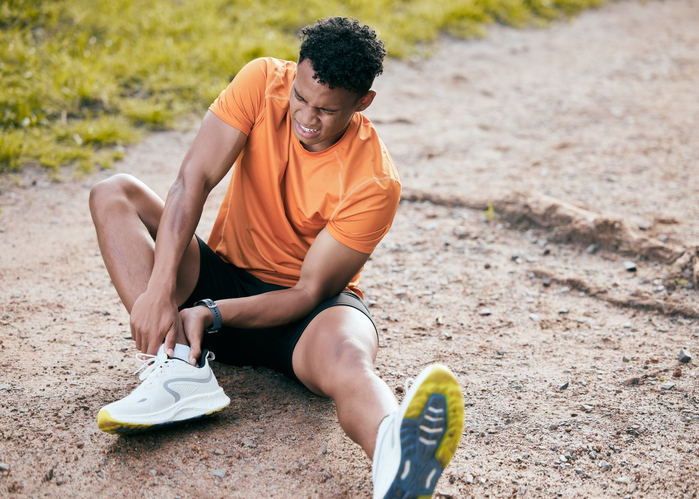

July 26, 2023
Sprains and strains are common injuries affecting the body’s soft tissue. Many people tend to think that sprains and strains are basically one in the same. But as medical professionals1 will tell you, sprains and strains are two different types of soft tissue injury.
Sprains and strains may have different symptoms. Treatment for sprains and strains can vary.
Your health care and well-being are our priority. That’s why we’re focused on medical education. That includes arming you with facts on sprains and strains—including symptoms, first aid, medical treatment, and prevention tips.
What are sprains?
A sprain is the stretching or tearing of ligaments. Ligaments are tough, elastic-like bands that connect bone to bone and hold your joints in place.1
Symptoms of sprains include:1
- Bruising
- Limited range of motion
- Pain
- “Popping” sound in your joint at time of injury
- Rapid swelling
Sprains most commonly happen in:
- Ankles
- Wrists
- Thumbs
- Knees
What are strains?
A strain is the stretching or tearing of muscle or tendon (tissue which connects muscle to bone). 1
Symptoms of strains include:
- Limited range of motion
- Muscle spasms
- Pain
- Swelling
Most common strains include:
- Elbows
- Lower back
- Hamstrings
Causes of sprains and strains
Sprains or strains occur when there is some kind of bodily trauma (resulting from a hit, fall, accident, or jarring movement). For example…
A sprained ankle—which usually affects the three ligaments on the outside of the ankle1—can happen when you roll, twist, or turn your ankle in an awkward way. This can stretch or tear the ligaments that help stabilize your ankle bones.
Wrist sprains commonly happen when people fall onto an outstretched hand.
Back strains can happen if you lift/carry something that’s too heavy or push your body (work/exercise) too hard.
Risk factors that commonly cause sprains and strains include:2
- Starting an exercise program too quickly
- Performing physically demanding work when you’re tired or sore (or have an existing injury)
- Wearing high-heeled shoes
- Wearing ill-fitting footwear for the task at hand
- Not using safe lift techniques
- Working on slippery/uneven surfaces
Prevention of sprains and strains
To help prevent risk of a sprain or strain:1
- Avoid exercise/sports when you’re tired or in pain.
- Maintain a healthy weight/eat a well-balanced diet to keep muscles strong.
- Invest in footwear with proper support and protection.
- Use sports equipment that properly “fits” your body.
- Practice safety measures to avoid falls/injuries.
- Warm up/stretch before physical activity.
- Be in shape to play a sport (rather than play a sport to get in shape).
- Find a doctor to advise on conditioning exercises and stability tips.
Treatment of sprains and strains
If it truly is a minor sprain or strain, it can often be treated at home using the RICE method for 24–48 hours.3
REST:
While rest to the injured area/limb is important, you can exercise other muscles to maintain conditioning while your sprain/strain heals.
ICE:
Apply ice immediately for 15–20 minutes, two to three times per hour, to reduce swelling and inflammation.
COMPRESS:
Wrap the area with elastic band to reduce swelling (starting at the point furthest from the heart to ensure blood circulation is not constricted or slowed).
ELEVATE:
Elevate the area above the level of the heart, particularly at night, as gravity allows for further reduction of swelling.
When to see a doctor for sprains and strains
All sprains and strains should be looked at by a doctor and properly diagnosed, though many can be easily treated at home.
Seek immediate emergency medical attention1 if:
- You can’t bear weight on the injured area (more than four steps causes significant pain).
- You have pain directly over the bones of an injured joint.
- Have numbness in any part of the injury.
Need help STAT? Stop by your nearest GuideWell Emergency Doctors and receive expert emergency care in half the time and one third the cost of an average ER visit
If you’re experiencing a life-threatening medical emergency, please call 911.
Sources:
1 https://www.mayoclinic.org/diseases-conditions/sprains/symptoms-causes/syc-20377938
2 https://share.upmc.com/2022/11/do-i-have-a-sprain-or-a-strain/?source=archive_title
3 https://share.upmc.com/2014/08/rice-method-for-treating-injury/
Terms and Conditions
GuideWell Emergency Medicine Doctors, LLC, is doing business as GuideWell Emergency Doctors, which are stand-alone urgent care facilities operated by Sanitas-USA. Sanitas-USA is a corporation that specializes in comprehensive medical care. Sanitas is a registered trademark owned by Keralty S.A.S.
*American College of Emergency Physicians
Cost is based on health plan actuarial analysis performed in 2016 that compared cost of hospital-based ER visit vs a GuideWell Emergency Doctors visit.